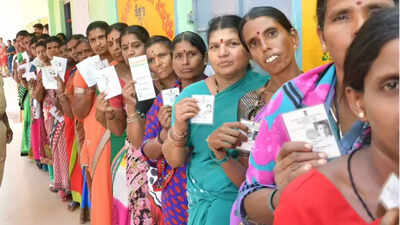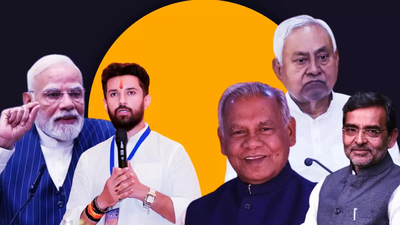NDA’s balancing act: Can Nitish Kumar and Chirag Paswan coexist? BJP walks the tightrope in Bihar | India News

NEW DELHI: The seat-sharing deal for the upcoming 2025 Bihar assembly election revealed a subtle but significant shift in internal power dynamics within the National Democratic Alliance (NDA). For the first time since the early 1990s, the two principal partners — the Janata Dal (United) (JD(U)), led by chief minister Nitish Kumar, and the Bharatiya Janata Party (BJP) — will contest 101 seats each in Bihar’s 243-seat assembly, while the Lok Janshakti Party (Ram Vilas) (LJP(RV)), led by Chirag Paswan, got 29 seats. For the first time, the BJP has secured equal seat-sharing in Bihar, ending the long-standing tradition of Nitish Kumar’s JD(U) playing the “big brother.” This parity between BJP and JD(U) underscores how BJP has shifted from the “junior” to an equal (or perhaps dominant) status in Bihar’s ruling coalition — while continuing to present Nitish as the face of stability.Meanwhile, LJP(RV)’s allocation of 29 seats — though modest in absolute terms — is significantly larger than typical junior-ally shares and includes visibility-rich constituencies: for example, in districts such as Jamui, Hajipur and Khagaria, where Dalit and youth demographics are strong.
The logic seems clear: BJP is hedging its bet—maintaining Nitish for his experience and stability, while elevating Chirag as a long-term ally and potentially a future power centre.
2020 fallout: When Chirag went solo
The backdrop to this shifting balance lies in the 2020 assembly election. In that election, JD(U) won just 43 seats, down from 71 in 2015 elections. Meanwhile, LJP fielded candidates on its own and acted as a vote-splitter. The result of this vote-cutting was a massive drop in the JD(U)’s seat tally, which fell from 71 seats in 2015 to just 43 seats in 2020. This was the JD(U)’s lowest tally in years and resulted in the party becoming the junior partner to the BJP for the first time in the NDA coalition in Bihar.As Chirag famously declared in October 2020, “I am Prime Minister Modi’s Hanuman… the PM lives in my heart.” His solo campaign was widely seen as an effort to weaken JD(U) while maintaining warmth toward the BJP.Nitish, for his part, responded with restraint. He welcomed the NDA’s overall victory but could not overlook how his party’s reduced tally had shifted the internal arithmetic — paving the way for BJP’s greater influence in coalition decisions.
Nitish’s declining arc
Nitish Kumar’s political journey has been defined by his reputation as “Sushasan Babu” — the administrator who once dominated Bihar’s politics. But by 2020, JD(U)’s footprint had shrunk and its strike rate fell sharply.Now, in 2025, BJP appears to be pursuing a dual strategy: keep Nitish visible as the stabiliser and face of continuity, while also nurturing Chirag as a parallel power centre. For BJP, that solves two problems at once: one, it retains the organisational strength and governance credentials associated with Nitish; two, it prepares for a future in which the LJP’s Dalit-youth base and rising profile may become more central.
What’s at stake?
For Nitish, the 2025 election is not just about retaining power—it’s about preserving relevance. If JD(U) fails to hold ground, Nitish may become a symbolic leader within his own alliance rather than its fulcrum.For Chirag, the 29-seat allocation marks his political breakthrough. He revealed that his party chose from a “pool of 38 seats” offered by BJP, stressing “quality over quantity.” His negotiation skills were on full display during the seat-sharing talks: engaging in multiple rounds with senior BJP and JD(U) leaders, he held firm until securing favourable terms. As a result, LJP(RV) emerged as the largest junior ally in the NDA. While BJP and JD(U) settled for 101 seats each, smaller allies — Jitan Ram Manjhi’s HAM and Upendra Kushwaha’s RLM — received only six seats apiece.This distribution positions Chirag as a key player in post-poll arithmetic, regardless of how the NDA performs overall.As for the BJP is concerned, the party seems to trying to thread the needle between coalition harmony and long-term dominance. If Nitish remains on board, BJP retains stability; if Chirag’s LJP strengthens, BJP gains leverage and a younger, more dynamic ally with reach into new caste and regional segments.Whether this triangular arrangement can sustain itself through the campaign — and beyond — will test the NDA’s cohesion like never before. Whether Nitish and Chirag truly coexist within the same alliance without their ambitions colliding remains to be seen.






